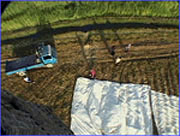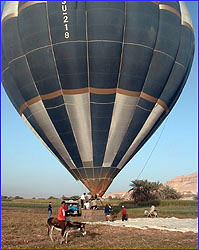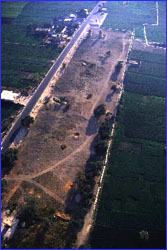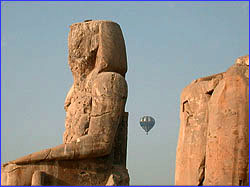
|
 |
 |
Balloon Flight Over Ancient Thebes by Peter Tyson March 12, 1999 One of the best ways to get a sense of the monumental architecture that obelisks epitomize is to fly over some of its finest examples in a balloon, as we did yesterday. Relive the flight with us now as we ponder from above the great mortuary temples of the Theban necropolis.
Yesterday dawned clear and still, with not a breath of wind - ideal ballooning weather. As the balloon crew waved us off, we ascended a few feet a second into the cloudless sky over the West Bank of Luxor. Bushy fields of grain, their heads heavy with ripe seed, spread east to the Nile about a mile away. Every now and then, our amiable pilot Yehia would fire up the gas jet, sending an obelisk of flame and the necessary hot air into the balloon's cavernous interior. Catching us off guard, the loud whoosh of the gas would suddenly extinguish all conversation. Otherwise, it was so silent you could hear a fellahin urging his donkey along a path 700 feet below.
Despite the boasting of its builder Amenophis III that it would be everlasting, the vast mortuary temple that once stood in back of the Colossi of Memnon has completely disappeared. Flooding and stone robbing have left but an empty field. Ironically, only the foundations remain of this sandstone edifice, the largest structure ever built on the West Bank.
Continue: The Ramesseum Explore Ancient Egypt | Raising the Obelisk | Meet the Team Dispatches | Pyramids | E-Mail | Resources Classroom Resources | Site Map | Mysteries of the Nile Home Editor's Picks | Previous Sites | Join Us/E-mail | TV/Web Schedule About NOVA | Teachers | Site Map | Shop | Jobs | Search | To print PBS Online | NOVA Online | WGBH © | Updated November 2000 |
 Takeoff video clip:
Takeoff video clip: Our balloon prepares for take-off from a field in
Luxor.
Our balloon prepares for take-off from a field in
Luxor.
 See the Colossi of Memnon at the top of this photo?
Amenophis III's mortuary temple once entirely filled
the brown field behind them.
See the Colossi of Memnon at the top of this photo?
Amenophis III's mortuary temple once entirely filled
the brown field behind them.
 Our balloon rises between the Colossi of Memnon.
Our balloon rises between the Colossi of Memnon.